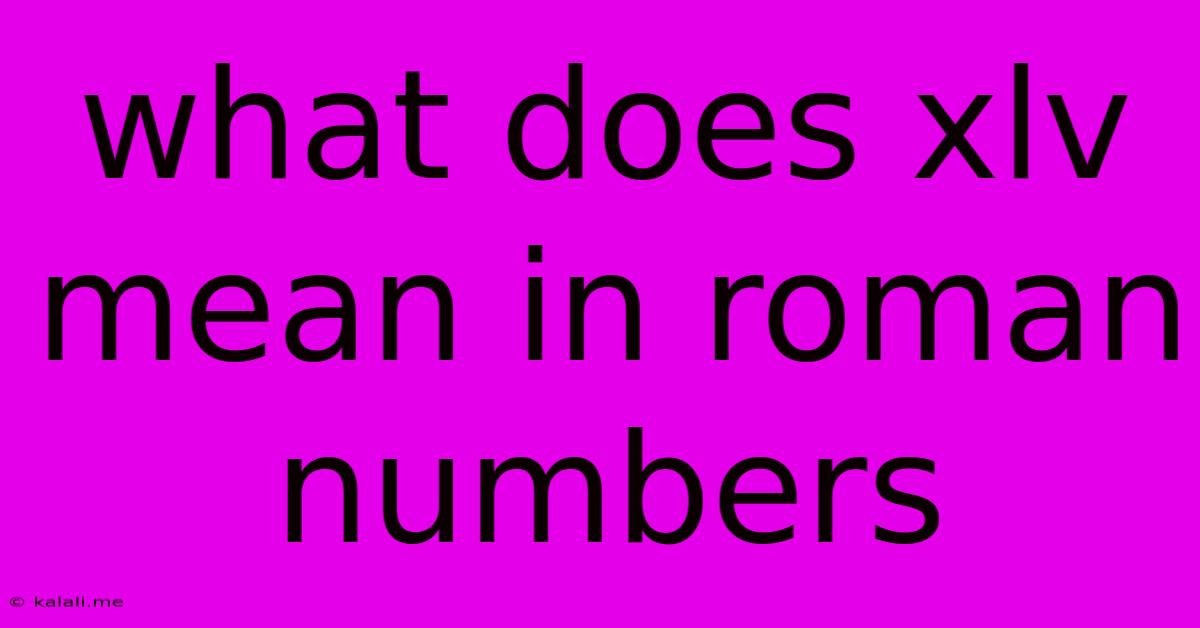What Does Xlv Mean In Roman Numbers
Kalali
Jun 15, 2025 · 2 min read

Table of Contents
What Does XLV Mean in Roman Numerals? Understanding Roman Number Systems
This article will delve into the meaning of XLV in Roman numerals, explaining the system and providing examples to solidify your understanding. Understanding Roman numerals can be helpful in various contexts, from deciphering historical dates to interpreting old documents or even appreciating architectural details. If you've ever wondered what XLV represents, you're in the right place.
Understanding the Basics of Roman Numerals
The Roman numeral system is a numerical notation system that originated in ancient Rome and is still used today for certain purposes. Unlike the decimal system we commonly use, Roman numerals use a combination of letters to represent numbers. The system relies on seven basic symbols:
- I = 1
- V = 5
- X = 10
- L = 50
- C = 100
- D = 500
- M = 1000
These symbols can be combined to create larger numbers. The key principle is that when a smaller value symbol precedes a larger value symbol, it's subtracted; otherwise, it's added.
Decoding XLV
Now, let's break down XLV:
- XL: Since X (10) comes before L (50), it's subtracted. Therefore, XL equals 50 - 10 = 40.
- V: This simply represents 5.
Therefore, XLV = 40 + 5 = 45.
Examples of Roman Numerals in Use
To further illustrate the system and its application, let's look at some additional examples:
- VI: 6 (5 + 1)
- IX: 9 (10 - 1)
- XIX: 19 (10 + 10 -1)
- XCIX: 99 (100 - 10 + 10 -1)
- CXXV: 125 (100 + 10 + 10 + 5)
Common Mistakes to Avoid
When working with Roman numerals, be aware of these potential pitfalls:
- Repetition: The same symbol can be repeated up to three times consecutively (e.g., III = 3, but IIII is not standard; instead, use IV for 4).
- Subtraction: Subtraction only applies when a smaller value symbol precedes a larger value symbol (e.g., IX is 9, but XI is 11). You can't subtract more than one value at a time (e.g., IC is not 99, it should be XCIX).
- Order: The symbols must be arranged in descending order of value, except for the subtractive principle.
Conclusion:
Understanding Roman numerals, even the more complex combinations, becomes straightforward with a grasp of the basic principles and a little practice. Now you know that XLV represents 45, a knowledge that can be useful in various situations. Remember the key concepts of addition and subtraction, and avoid common mistakes, and you'll be well-equipped to decode Roman numerals effectively.
Latest Posts
Latest Posts
-
1 Meter Equals How Many Nanometers
Jun 16, 2025
-
Which Of The Following Is An Exothermic Reaction
Jun 16, 2025
-
Difference Between Starch Glycogen And Cellulose
Jun 16, 2025
-
Gpa Requirements For Columbus State University
Jun 16, 2025
-
Which Of The Following Is Not A Social Institution
Jun 16, 2025
Related Post
Thank you for visiting our website which covers about What Does Xlv Mean In Roman Numbers . We hope the information provided has been useful to you. Feel free to contact us if you have any questions or need further assistance. See you next time and don't miss to bookmark.